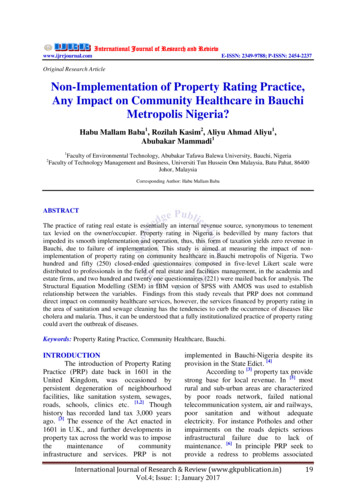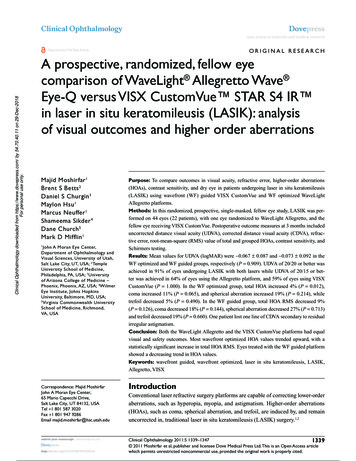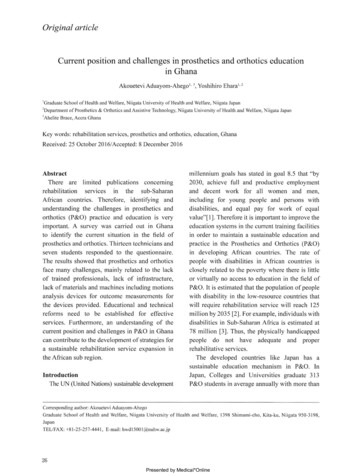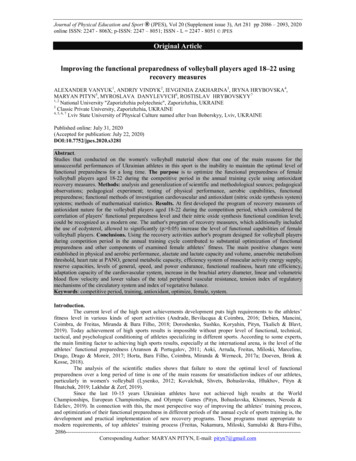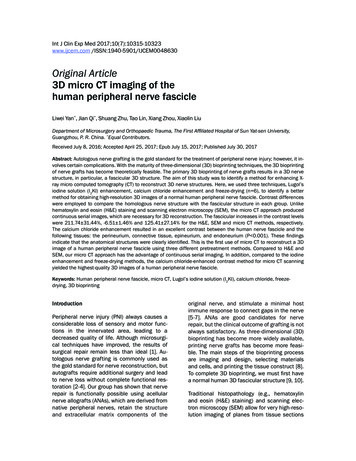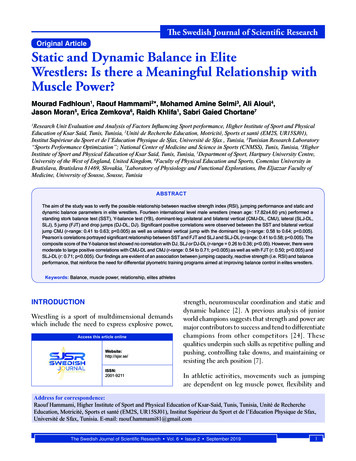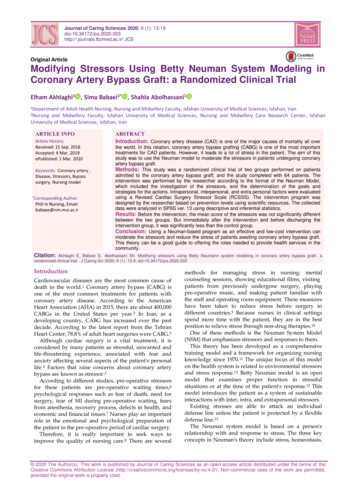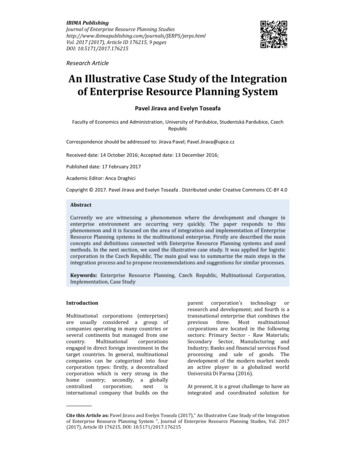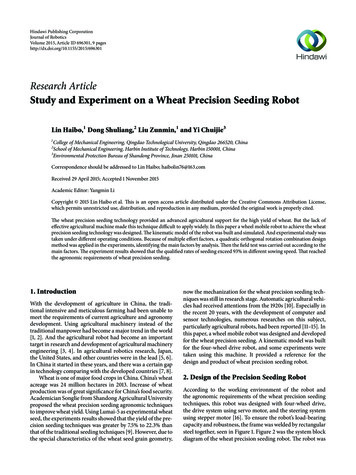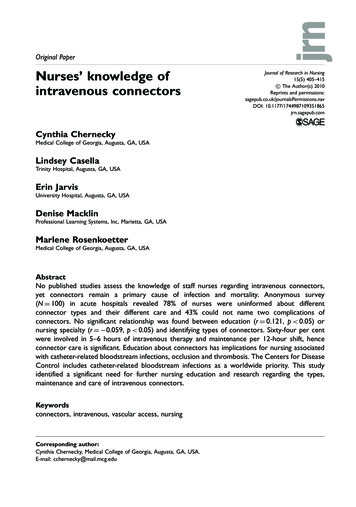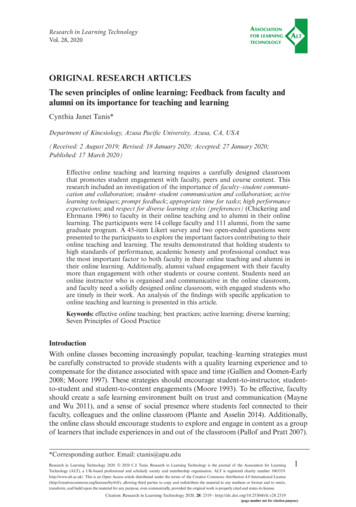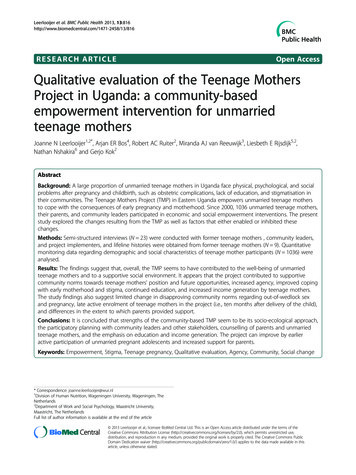
Transcription
International Journal of Health Sciences and Researchwww.ijhsr.orgISSN: 2249-9571Original Research ArticleTo Study the Effect of Buteyko Breathing Techniquein Patients with Obstructive Airway DiseaseRachna. D. Arora, Visalakshi. H. SubramanianPT School & Center, T.N.M.C. & B.Y.L. Nair Ch Hospital, Mumbai, IndiaCorresponding Author: Rachna. D. AroraABSTRACTBackground: The Buteyko Method, a breathing technique, has been found to be effective inindividuals with asthma and a range of other conditions. In the present study, an attempt was made tocompare the effect of Buteyko Breathing Technique in patients with obstructive airway disease.Aim: To study the effect of Buteyko Breathing Technique in Obstructive Airway DiseaseObjectives:To assess the pre and post changes on outcome measures in control group & in experimental grouprespectively.To compare the effect on outcome measures in both the groups.Methodology: The subjects were screened to select 28 patients. The Control group receivedconventional Physiotherapy and Experimental group received Conventional Physiotherapy withButeyko breathing technique. The treatment was given thrice a week for both the groups for 4 weeks.All the outcome measures i.e. Single Breath Count Test (SBCT), Resting Respiratory Rate (RestingRR) , Breath Holding Time (BHT), Percent Predicted Value of 6 Minute Walk Distance (%PV of6MWD) & Peak Expiratory Flow Rate (PEFR)were recorded at baseline and post treatment in boththe groups.Result: In control group, there was statistically significant increase in SBCT (p 0.001), BHT(p 0.000), PEFR (p 0.000), % PV 6MWD (P 0.006), reduction Resting RR (p 0.000) & RestingHR% (p 0.275). In Experimental Group, there was a statistically significant increase in SBCT(p 0.000), BHT (p 0.001), % PV 6MWD (p 0.001), PEFR (p 0.008), reduction Resting RR(p 0.000) & Resting HR% (p 0.000). On comparing the differences between both groups,statistically significant increase was found in BHT (p 0.002), SBCT (p 0.014), % PV 6MWD(p 0.097), PEFR (p 0.098) & significant reduction was found in Resting HR% (p 0.000) & RestingRR (p 0.005).Conclusion: Buteyko Breathing was effective in improving breathing control, breath holding andreducing the work of breathing in subjects with Obstructive Airway disease.Keywords: Obstructive Airway Disease, Bohr Effect, Buteyko Breathing TechniqueINTRODUCTIONObstructive lung disease is acategory of respiratory disease characterizedby airway obstruction. Many obstructivediseases of the lung result from narrowingof the smaller bronchi and largerbronchioles, often because of excessivecontraction of the smooth muscle itself(V.K. VIjayan, 2013). It is generallycharacterized by inflamed and easilycollapsible airways, obstruction to airflow,problems exhaling and frequent medicalclinic visits and hospitalizations. Types ofobstructive lung diseases are al Journal of Health Sciences & Research (www.ijhsr.org)Vol.9; Issue: 3; March 201950
Rachna. D. Arora et.al. To Study the Effect of Buteyko Breathing Technique in Patients with ObstructiveAirway Diseasebronchiolitis (OB) (Shilpa P. Karande er al.,2016).AccordingtoWorldHealthOrganization estimates, 65 million peoplehave moderate to severe COPD. More than3 million people died of COPD in 2005corresponding to 5% of all deaths globallyand it is estimated to be the third leadingcause of death by 2030.Airflow limitation isusually progressive and is associated withan abnormal inflammatory response oflungs to noxious particles or gases. Patientcomplains primarily of incapacitatingdyspnoea and reduced Functional Capacity,leading to hyperventilation (Diagnosis andAssessment, updated 2013 & Christinemilelsons, 2008).The Buteyko Method, one of manyhealth-promoting breathing techniques tooriginate from Russia, made its way toAustralia, Europe, and the United States inthe 1990s. The technique has been found tobe effective in individuals with asthma anda range of other conditions from anxiety tosleep apnea (Ameisan, 1997; Stalmatski,1999; Stark & Stark, 2002). The method isnamed after its originator, Dr. KonstantinPavlovich Buteyko, who claimed that hisprogram of breathing retraining could cure alarge number of the chronic ailmentsaffecting modern society. His early work inthe 1960s centered on the use of breathingretraining for diseases of the circulatorysystem and the respiratory system. Overtime, doctors working in Buteyko’s clinicsin Moscow, Siberia, and the Ukraine alsoclaimed success in treating diabetes,psychological disorders, immune andmetabolic disorders, and reproductivedisorders.Buteyko’s method rests very muchon his carbon dioxide theory of disease, andthe primary aim of the breathing techniquesis to raise carbon dioxide levels. Buteykoclaimed chronic hyperventilation to be awidespread, important, and generallyunrecognized destabilizer of physiologicalsystems and psychological states. It isknown that low carbon dioxide affects manysystems of the body either directly orthroughsubsequentdepletionofbicarbonate, pH disturbance, and reducedtissue oxygen levels (Folgering, 1999;Gardner, 1995; Hardonk& Beumer, 1979).However, Buteyko and his Russiancolleagues elaborated on the conventionallyaccepted effects of hypocapnea. Theyargued that depletion of carbon dioxideaffected the core processes of energyproduction (Krebs cycle within the cell),vital chemical reactions requiring carboncompounds and other key homeostaticprocesses. In Buteyko’s view, becausecarbon dioxide was so vital, the bodycreated a series of defence mechanisms toretain carbon dioxide, including constrictionof airways and blood vessels, and gave riseto conditions such as asthma andhypertension (Buteyko, 1990; Stark &Stark, 2002). According to the physiologicalresponse of body, blood uses carbon dioxideto improve oxygen distribution to cells (TheBohr Effect) (Bohr et al., 1997 & Olson JSet al., 1972)In case of hyperventilation there is aproportionate exhalation of carbon dioxideas to the inhalation of oxygen, leading to adecline in the net amount of carbon dioxidein blood. Thus, there is less oxygen supplyleading to weak health and chronic disease.THE BOHR EFFECTFigure 1: Illustration of Bohr Effect.METHODOLOGYResearch Design: Experimental, parallelgroup, prospective studySample Population: Patients with moderateto severe airflow limitation.International Journal of Health Sciences & Research (www.ijhsr.org)Vol.9; Issue: 3; March 201951
Rachna. D. Arora et.al. To Study the Effect of Buteyko Breathing Technique in Patients with ObstructiveAirway DiseaseType Of Sampling: Purposive sampling.Patients were randomly assigned toexperimental & control group with the helpof block randomization using block of fourSource Of Sampling: Chest medicine OPDof tertiary health care hospitalPlace of Study: Physiotherapy OPDDuration of Study: 18 Months (May 2016TO October 2017)Sample size:The sample size was calculated using theprevious study titled “Effect of singingclasses on quality of life and functionalcapacity in subjects with mild to moderateairflowlimitationAprospectiveexperimental study”, the mean differenceand SD of primary outcome measure (SingleBreath Count Test) in intervention groupwas 4 1.7 with a large effect size.Conventional Physiotherapy showed nochange in Single Breath Count Test.Considering that Buteyko Technique willproduce similar effect, minimal clinicaleffect size is calculated asN 2(Zα Z1-β)2 σ2 / d2The Sample size came as 28 including thesamples for dropouts.So, the Sample size for each group (n) N/2 28/2 14Inclusion criteria: Patients with FEV1/FVC ratio 0.7 30% FEV1 79% of predicted. Resting Respiratory Rate 24. Patients willing to participate.Exclusion criteria: Admission in any hospital due to acuteexacerbation in the last 4 weeks Myocardial complications like acuteHypertension & recent History of anycardiac disease Musculoskeletal painOUTCOME MEASURES: Single Breath Count Test (SBC)Score was taken as the number of countspoken in 1 breath Resting Respiratory Rate (RestingRR)The number of breaths taken in a singleminute at rest was recorded against thesound of a metronome Breath Holding Time (BHT)The time for which a single breath can beheld after complete exhalation wasrecorded.Percentage Predicted Value of 6 Minutewalk distance (% PV of 6MWD) :a) 6MWDb) Reference equation was used to calculatePV of 6 MWD (Ramanathan Palaniappan,2014)Male 561.022 - (2.507 age (yr)) 1.505 weight (kg)) - (0.055 height (cm))Indian female -30.425-(0.809 age(yr)) (2.074 weight(kg)) (4.235 height(cm))c) Percentage PV of 6MWD6MWD% PV OF 6MWD Predicted value 100 Peak Expiratory Flow Rate(PEFR)In the upright sitting position the subjectswere given the cartoon mouth piece that wasadjusted to the mouth piece of the peakexpiratory flow meter. The pointer isswitched to zero. Instruction is given to thesubjects to hold the peak flow meter level(horizontally) and to keep their fingers awayfrom the pointer. The subjects are asked totake a deep breath and close the lips firmlyaround the cartoon mouthpiece & blow ashard as they can as if blowing out candles.The reading over the peak flow meter ismeasured and the pointer is switched backto zero. The procedure is repeated for 3times and highest reading is recorded.PROCEDUREThe approval for the study wassought from the local institution ethicscommittee. Block randomization methodusing block of four was used for randomallocation of patients to experimental(Buteyko and conventional) and controlgroup (conventional). It was done prior tocommencement of the study by anindependent person and sealed in separate,opaque, numbered envelops.International Journal of Health Sciences & Research (www.ijhsr.org)Vol.9; Issue: 3; March 201952
Rachna. D. Arora et.al. To Study the Effect of Buteyko Breathing Technique in Patients with ObstructiveAirway Disease40 patients with airflow limitationcoming to Chest Medicine OPD werescreened out of which 28 were recruited. 8patients did not meet the inclusion criteria &4 patients refused to give consent toparticipate in the study. There were 3dropouts in the study, 2 in control group and1 in the experimental group, due to loss offollow up.Study procedure was explained and writtenconsent was taken from the etric measures, vital parameters,recent PFT parameters, co-morbidities andinformation regarding current medication ofthe participant was taken.As the participants were recruited,the sealed numbered envelops were openedand accordingly the participants wereallocated to Control and Experimentalgroups.The Control group received conventionalchest Physiotherapy and Experimentalgroup received Conventional Physiotherapywith Buteyko breathing technique.The treatment was given thrice aweek for both the groups for a duration of 4weeks & the number of sessions in both thegroups were recorded. The experimentalgroup subjects were called on Mondays,Wednesdays & Fridays & the control groupsubjects were called on Tuesdays,Thursdays & Saturdays to ensure nointeraction of subjects between the groups.All the outcome measures ie singlebreath count test, resting respiratory rate,breath holding time, 6 MWT (as perAmerican Thoracic Society or ATSguidelines) and peak expiratory flow rate(PEFR) were recorded pre and posttreatment sessions in both groups by anindependent assessor. The PEFR was testedthrice and the best score was taken.CONTROL GROUP: The control groupreceived Conventional Chest Physiotherapythrice a week for 4 weeks. The sessionincluded Nebulization Postural drainage Breathing control exerciseBreathing control exercise includeddiaphragmatic breathing exercises withpursed lip breathing exercises. In this thesubjects placed their hands on the anteriorcostal margins and upper abdomen to feelthe movement occurring. This was followedby breathing in gently and concentrating onallowing the abdominal wall to swell gentlynot forcibly, under the slight pressure oftheir hands. On breathing out with slightlypursing the lips, they felt the abdomenslowly sinking back to rest. The upper chestand shoulder muscles remained relaxed. Thesession lasted for 15-20 minutes.EXPERIMENTALGROUP:Theexperimental group practiced Buteykobreathing technique through a video for 20minutes in addition to the conventionalphysiotherapy with total session durationvarying from 35 – 40 minutes.Buteyko Breathing consisted ofnasal breathing & the subjects inhaledthrough nose keeping the mouth closed &exhaled through nose to remove air fromlungs. Then the subjects were instructed tohold the breath until they felt the urge toinhale. This cycle of nasal breathing wasrepeated with a rest period varying from 30seconds to 2 minutes in between each cycle.During the breathing sessions participants’oxygen saturation was continuouslymonitored for patient safety. The techniquewould be discontinued if there was a fall inoxygen saturation. However, during thetreatmentsessions,noparticipantcomplained of any discomfort nor was therea drop in oxygen saturation. Two to threesessions were required for the participantsget familiarized with the breathingtechnique.After 4 weeks, the outcomemeasures of both the groups were recorded.In experimental group, there was one loss offollow up and 13 patients completed thestudy. In control group, there were 2 loss offollow up and 12 patients completed theInternational Journal of Health Sciences & Research (www.ijhsr.org)Vol.9; Issue: 3; March 201953
Rachna. D. Arora et.al. To Study the Effect of Buteyko Breathing Technique in Patients with ObstructiveAirway Diseasestudy. The data of 13 & 12 patients wererecorded and analysed.Schematic Representation of MethodologyAfter collection of data, data sheet wasprepared and statistically analysed.TOTAL 40 PATIENTS SCREENED12 PATIENTS EXCLUDED8 DIDNOT MEET THE INCLUSION CRITERIA4 REFUSED TO PARTICIPATE28 PATIENTS INCLUDED IN THESTUDYBASELINE ASSESSMENT OF
The Buteyko Method, one of many health-promoting breathing techniques to originate from Russia, made its way to Australia, Europe, and the United States in the 1990s. The technique has been found to be effective in individuals with asthma and a range of other conditions from anxiety to sleep apnea (Ameisan, 1997; Stalmatski,
